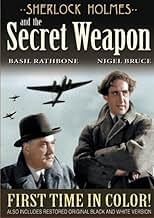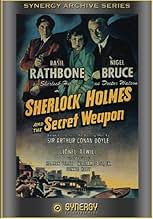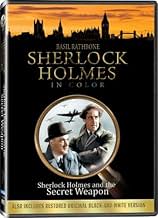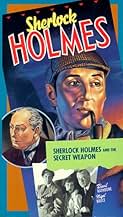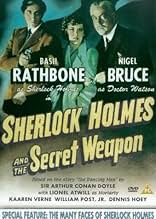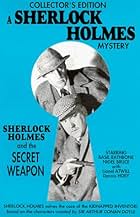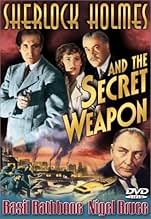Sherlock Holmes et l'Arme secrète
- 1942
- Tous publics
- 1h 8min
Sherlock Holmes exfiltre le Dr. Franz Tobel de Suisse avant que les allemands ne s'emparent de son invention : un viseur de bombardement. Mais, les dangers ne sont pas pour autant écartés au... Tout lireSherlock Holmes exfiltre le Dr. Franz Tobel de Suisse avant que les allemands ne s'emparent de son invention : un viseur de bombardement. Mais, les dangers ne sont pas pour autant écartés au pays de Sa Majesté en la personne de Moriarty.Sherlock Holmes exfiltre le Dr. Franz Tobel de Suisse avant que les allemands ne s'emparent de son invention : un viseur de bombardement. Mais, les dangers ne sont pas pour autant écartés au pays de Sa Majesté en la personne de Moriarty.
- Réalisation
- Scénario
- Casting principal
- Charlotte Eberli
- (as Kaaren Verne)
- Braun
- (non crédité)
- Barfly
- (non crédité)
- London Bobbie
- (non crédité)
- Bar Singer
- (voix)
- (non crédité)
- Swiss Waiter
- (non crédité)
- RAF Officer
- (non crédité)
- Woman RAF Pilot
- (non crédité)
- Scotland Yard Man
- (non crédité)
- Jack Brady
- (non crédité)
- RAF Officer Watching Bombsight Test
- (non crédité)
Avis à la une
Then the franchise was moved to Universal Studios and a series of mostly declining quality was established. This was an early example. It's not terrible, not embarrassingly bad, it just loses something in being updated to the 1940s and in not having the atmosphere Conan-Doyle managed to inject into his characters and into the atmosphere itself. Not to mention some of Conan-Doyle's sometimes unwittingly delicious bon mots -- "The wind sobbed like a child in the chimney."
"The Secret Weapon" doesn't tell us much we don't already know about Holmes and Watson. There is a variation on Conan-Doyle's "Dancing Men" but not really much else that's too interesting. I never cared much for Lionel Atwill as an actor, and he looks especially clunky as Moriarty. Moriarty should be a reptilian ectomorph with an oscillating head.
Still, this is okay for fans of the series. Homes wears his hair combed from back to front on the sides, which is a little different. I wish the code had allowed him to do some cocaine once in a while. The best of the Universal films was unquestionably "The Scarlet Claw," so if you have to choose, choose that one to watch.
Although I'm not a major fan of the Holmes films where he finds himself in the modern day world, this is one of the better ones I have seen thus far. The plot is a little thick at the start but really gets going when the scientist goes missing. The investigation by Holmes is very engaging and the climax has a nice couple of scenes where Holmes and Moriarty match wits.
Rathbone makes a good Holmes as always and here he happily hasn't as bad a haircut as he did in some of the modern films. Bruce is much better than usual - he is less of a mug and is made less fun of by Holmes, he actually shows a bit of sense about him. Indeed so does Lestrade (Hoey), so often a comedy figure, it's nice to see him involved a bit more than usual! Atwill's Moriarty is good but I always saw him as a leaner, meaner man - Atwill looks more like Watson than Sherlock, even though their battle of wits is good I never felt that he was any match for Holmes, never mind being a nemesis.
Overall I enjoyed this film. It does have a small bit of propaganda at the very end but, unlike some of the other films, doesn't ram it down your throat - by making it about Moriarty rather than Nazi goons, the film works better. It has a slow start but it opens up to be very enjoyable.
Moriarty appears in three of the Holmes films with Rathbone. In THE ADVENTURES OF SHERLOCK HOLMES he was played by George Zucco, who gave real relish to the love of villainy for its own sake to the role. For my money Zucco's performance as the Professor was the best of the three (there is even a brief moment of comedy in his performance, when he's disguised as the "Sergeant of Police" towards the end - like he's preparing to sing "A Policeman's Lot" from Gilbert & Sullivan). Next comes Mr. Atwill's performance here - more of that later. Finally there is Henry Daniell's intellectual Moriarty in SHERLOCK HOLMES AND THE LADY IN GREEN. It's a typically cool, classy performance by Mr. Daniell, but his confrontations with Holmes seem to be a tedious bore to him. They keep him from completing the main plan. In the stories that the Professor pops up in, he really senses Holmes is a nemesis who will remain a danger as long as he is alive. Yet, because of the intellectual tennis match between him and Rathbone, Rathbone (in his autobiography) actually felt Daniell was the best of the film Moriartys.
If Zucco captured the love of evil in the Professor, and Daniell seemed to demonstrate the tired Oxford Don (in the stories the Professor is a well regarded mathematician, whose volume on the binomial theorem had a "European vogue", and who wrote an intriguing book, THE DYNAMICS OF THE ASTEROID), Atwill demonstrates the Professor as pragmatic businessman. First of all, he's sold his services (apparently) to Nazi Germany. This is never gone into, but one presumes (as this is before the Nazis began to really collapse) he figures they will win the war. Secondly, he is not a fool. When Dr. Tobel (William Post Jr.) has shown he is a state of near physical collapse due to the torturing of Moriarty's gang, the Professor decides to kidnap one of the other scientists who are assisting Tobel, because he's as good a scientist as Tobel and would be able to put together the bomb site. I somehow can't quite see Zucco making such a sensible decision on the spot, and if Daniell had to make it, he would seem annoyed that there is yet another delay to his plans.
By the way, one trick used in all the Holmes series regarding the Professor is how to rid the film of him. If you read the Holmes stories, Moriarty appears as the villain three times: in THE MEMOIRS OF SHERLOCK HOLMES' last story ("THE ADVENTURE OF THE FINAL PROBLEM"), in THE RETURN OF SHERLOCK HOLMES' first story ("THE ADVENTURE OF THE EMPTY HOUSE") and the last of the four novels/novellas (THE VALLEY OF FEAR). It's amazing how much mileage the Professor got out of so few appearances (he is mentioned in two or three other stories as well - in passing). But because of his fate at the Reichenbach Falls in "THE FINAL PROBLEM" and "THE EMPTY HOUSE", we always see him fall to his death. Zucco falls off the White Tower on Tower Hill. Daniell (with more imagination) tries to flee Gregson and the police, but is shot as he jumps, and wounded fails to hold on to the wall of an adjacent building. Atwill (here it is not seen, but heard) seems to fall down a trap door he's planted in an escape tunnel). It is really tedious after awhile to see the Professor always fall in these films. One turns to the Gene Wilder comedy (admittedly a comedy) SHERLOCK HOLMES' SMARTER BROTHER, wherein Leo McKern is a wonderfully wacky and villainous Moriarty (complete, finally, with an Irish accent), who is not killed at the end, but just left mulling - in a rowboat - over how his careful schemes did not work out. I rather liked that better.
The use of the "Dancing Men" code here, like the use of the "Devil's Foot Root" in DRESSED TO KILL, snags a part of a mystery from a short story. "THE ADVENTURE OF THE DANCING MEN" appeared in THE RETURN OF SHERLOCK HOLMES, and deals with a client of Holmes whose wife has been getting weird, blood-curdling messages in this code. Charles Higham, in his biography THE ADVENTURES OF CONAN DOYLE suggests Sir Arthur may have picked up the code from a magazine game in the 1870s, but we really don't know. The code is basically one of letter substitutions for the figures of the dancing men. The story in the short story is dramatic, but deals with a triangle. The only innovation in the film is that Tobel makes a slight change that confuses both Holmes and Moriarty.
The film will entertain, but I still think THE HOUSE OF FEAR, THE SCARLET CLAW, and SHERLOCK HOLMES FACES DEATH are better films.
Moving Sherlock Holmes to the 1940s sounded like a stupid idea but it does work for one reason--Basil Rathbone. Arguably he is the BEST Sherlock Holmes ever put on the screen. He plays the character so well (and accurately) that it doesn't matter what era he's solving crimes. As for Nigel Bruce as Watson...everybody has problems with it. He plays Watson as a bumbling old fool...that is NOT the Watson of the books. You seriously wonder why Holmes puts up with him. Still, he does grow on you (in a way). Then there's Atwill having a whale of a time playing Moriarty--the discussions and battle of wits between him and Holmes are just great! I've never liked Dennis Hoey as Inspector Lestrade--he's such an idiot. Makes Watson look like a genius. And Post Jr. is pretty good as Tobel (even though his accent amusingly keeps changing!).
This movie is done elaborately and runs only a little over an hour. Still, it does have it's slow spots and I never understood the secret code section.
Still, worth catching if just for Rathbone and Atwill.
Holmes and Dr. Tobel arrive safely back at Baker Street but the scientist would rather be alone, for some mysterious reason, although he had promised the English to help them, not the Germans. He stays true to that promise but there are some desperate moments for Holmes and the English along the way.
It's an entertaining film and one in which our famous detective uses not one but three different disguises. He needs all the help he can get when he goes up against his arch-rival, "Professor Moriarity." One complaint: if Moriarity was that evil, he would have dispensed with Holmes without batting an eyelash, instead of giving him openings to escape. It's pretty sad, too, when the usual dim-witted Dr. Watson (Nigel Bruce) has to rescue his boss from certain death a couple of times!
Yes, there are some credibility issues in this story but if you can put your brain on hold a few times, it's a fun film to watch....and it looks beautiful, thanks to the great restoration job done on this DVD. It makes the old print come alive with some wonderful visuals, particularly the night-time shots.
One other note: whoever did the English subtitles in here misspelled or misinterpreted at least a half dozen words. It's very sloppy work, and not the first time I've encountered this watching the entire series on the restored DVD set.
Le saviez-vous
- AnecdotesThe set used for Prof. Moriarty's hideout was used as a pub/bar in Sherlock Holmes et la voix de la terreur (1942).
- GaffesWhile Holmes is in Switzerland, disguised as a book collector, he drives in a car with the steering wheel located on the right side while driving on the left side of the road. In Switzerland (and in Germany, as well, so "the Nazi's own car" would also be configured the same way), people drive cars on the right side with steering wheels mounted on the left side. The only areas of Europe where cars are right-hand-drive and occupy the left-hand lane are the British Isles and Gibraltar. A probable explanation for this apparent discrepancy is the film's overall British overtone --- the tale's primary setting is London and many of the lead actors are from England, so this is likely why British-configured cars were used.
- Citations
Professor Moriarty: Brilliant man, Sherlock Holmes. Too bad he was honest.
- Crédits fousOpening credits prologue: SWITZERLAND
- Versions alternativesAlso available in a computer-colorized version.
- ConnexionsEdited into Who Dunit Theater: Sherlock Holmes and the Secret Weapon (2016)
- Bandes originalesRule Britannia
(1740) (uncredited)
Music by Thomas Augustine Arne
Played in the score when London is shown
Meilleurs choix
- How long is Sherlock Holmes and the Secret Weapon?Alimenté par Alexa
Détails
- Date de sortie
- Pays d’origine
- Langues
- Aussi connu sous le nom de
- L'Arme secrète
- Lieux de tournage
- Société de production
- Voir plus de crédits d'entreprise sur IMDbPro
- Durée1 heure 8 minutes
- Couleur
- Rapport de forme
- 1.37 : 1
Contribuer à cette page



